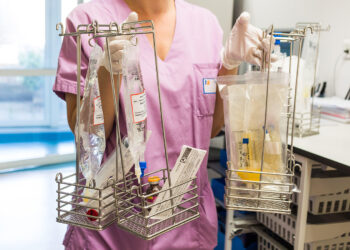[ad_1]
More than five million women are not up to date with their routine cervical screening, according to NHS England. In 2023, it pledged to eliminate cervical cancer by 2040 by improving access to screenings and HPV vaccinations.
What might the future of cervical screening look like, and how can general practice contribute to meeting this target?
Self-Sampling Shows Promise
One solution could be to offer self-sampling human papillomavirus (HPV) tests so that women could complete cervical screening at home. A 2024 YouScreen trial by King’s College London investigated the effectiveness of this approach. The study, published in eClinicalMedicine, involved 133 GP practices in north and east London. Patients who were at least 6 months overdue for screening were offered self-sampling kits by the participating practices. 8338 patients provided a self-sample after recruitment.
In some parts of London, non-attendance rates for cervical screening are as high as 50%. Yet within a month of the YouScreen study, screening take up rates in the participating practices had increased by 22%.

Lead author, epidemiologist Dr Anita Lim, PhD, said the results demonstrated the effectiveness of this method.
“Self-sampling has been hailed as a game-changer for cervical screening and we now have evidence in a UK population to show that it really is,” she explained. “It is crucial we make cervical screening easier for women by introducing innovations like self-sampling, alongside the current cervical screening programme, to ensure that they are protected from what is a highly preventable cancer.”
Other countries, including the Netherlands, Austria, Denmark, and Sweden, have already adopted self-sampling to improve screening rates.
Easier Appointment Booking
A 2024 Healthwatch survey of 2400 women found that 52% wanted a wider choice of appointment times, including early mornings, evenings, and weekends. Just under half of respondents said drop-in sessions and booking via the NHS app could encourage attendance.
On the latter front, this is something NHS England is planning to introduce in the longer term. In spring 2025, the NHS will also introduce a new ‘ping and book’ service where patients will receive cervical screening alerts by phone to remind them when they are due or overdue for an appointment.
Booking an appointment can also be an obstacle, with some people finding the process complicated. In north London, a practice group has been trialling the use of an AI-powered receptionist to help people book and rearrange appointments via WhatsApp. Patients have described booking via the chatbot, Asa, to be “so much more convenient”.
Of course, a digital only approach wouldn’t work for everyone, so maintaining the ability for patients to book appointments by telephone would also be needed.
Addressing Barriers to Screening
A 2022 study in the British Journal of General Practice examined the challenges and opportunities of screening patients aged 50 years and over.

Many of the women surveyed said they had never been asked by their GP why they had missed screenings. However, a GP who was involved in the study said it could be difficult for doctors to lead on this. “When a GP opens a patient’s record, they usually get alerts about the patient, and not attending cervical screening is quite often one of those,” said Dr Una Macleod, a GP, RCGP fellow, and dean and professor of primary care medicine at Hull York Medical School.
“The trouble is people suggest that GPs should do this opportunistically – when a patient comes in for an appointment. But when patients have an issue they want to discuss, that’s why they’ve made that appointment. So, it’s quite difficult then for GPs to instigate an in-depth conversation about why a patient might be overdue for a cervical screening.
“But signposting to a practice nurse or encouraging patients to chat through their concerns with a practice nurse could be a workable alternative,” Macleod added.

GPs would ideally like to have these kinds of conversations with patients, but time constraints mean it is not currently possible, according to Dr Lizzie Toberty, a GP lead for Doctors’ Association UK. “It would be amazing if GPs had the funding and time allotted to discuss all sorts of health promotion in a personalised, tailored way,” she explained. “However, it is often a struggle to get through the problems that the patient is presenting with and not run late.”
While general practice had “so much potential” to influence health outcomes, the service is “woefully underfunded”, Toberty said. “If as a society, we want to prioritise women’s health, we need to fund schemes to target marginalised groups.”
Having a system in place so GPs are aware who has fallen behind with their routine checkups could help, suggested Macleod. Talking about cervical screening during women’s health discussions with patients could also work well, she said.
“For example, it could be discussed as part of postnatal checks and during contraception discussions. The challenge is with older women but when they attend to discuss their menopause symptoms, this could be a good opportunity to highlight cervical screening and also tackle any misconceptions that they aren’t at risk, for example.”
Reaching Older Women
Macleod’s research found that some older women felt no longer being sexually active or only ever having one sexual partner meant they didn’t need to be screened. “Yet because cervical cancer is HPV driven, they could still be at risk as if they have HPV via a previous sexual partner, for example. The virus will continue to hang around,” she explained.
The NHS offers cervical screening to women up to the age of 64. If women have had an HPV test before they stop screening, they are deemed to be at very low risk of developing cervical cancer. However, not all older women have had a test for HPV, and this can increase their risk.
To address this, the London School of Hygiene and Tropical Medicine began a pioneering HPV catch-up screening project in 2023. The initiative, involving GP practices in Manchester and the Yorkshire and Humber region, offered urine-based HPV tests to women aged 60 to 79 who were no longer being screened. Patients were asked to provide a urine sample, and the test proved to be as good as a traditional Pap smear. Macleod, who participated in the project, said that offering at-home testing could be beneficial for encouraging both younger and older women to get screened.
“We had a really good uptake, interestingly,” she added. “Some of the women had been to all of their screenings but since their last attendance, the screening programme had changed to check for HPV. I think this space will change, and I’d be very surprised if it didn’t over the next 5 or 6 years.”
Julie Penfold is a freelance journalist specialising in healthcare and medical content.
[ad_2]
Source link : https://www.medscape.com/s/viewarticle/patient-first-strategies-boost-cervical-screening-2025a10002ha?src=rss
Author :
Publish date : 2025-01-31 10:57:23
Copyright for syndicated content belongs to the linked Source.














